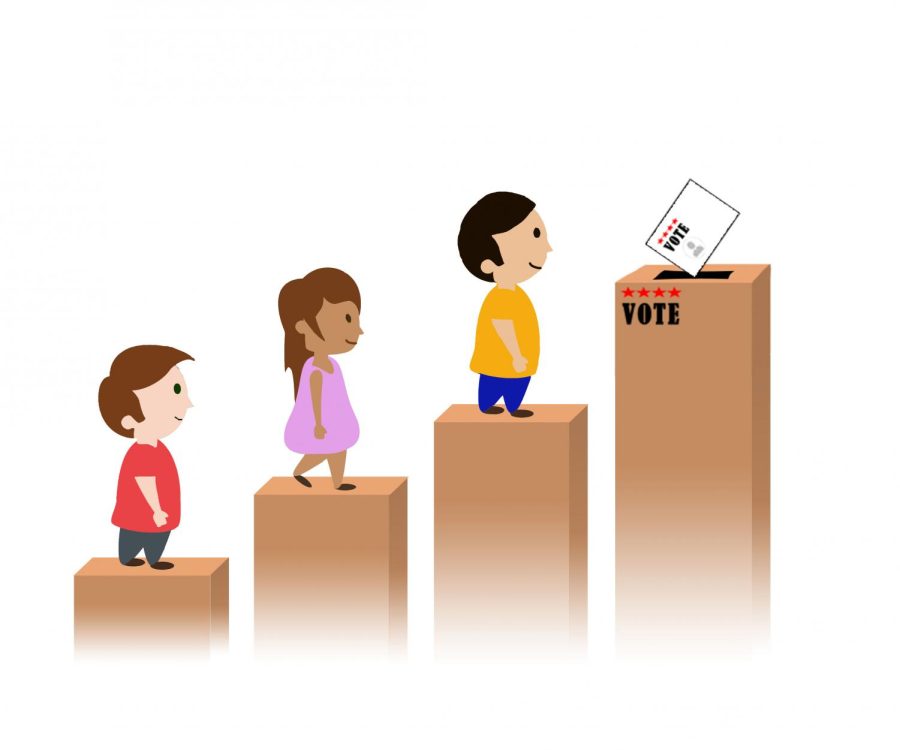In-state election policy changes
Graphic illustration by News Section
In accordance with the California Voter’s Choice Act (VCA) that was passed in 2016, Santa Clara County (SCC) is making efforts to ease the voting process, diversify voter demographics and increase participation.
February 26, 2020
With the primary elections quickly approaching, California has made several efforts to increase voter participation by modernizing the election process. In accordance with the California Voter’s Choice Act (VCA) that was passed in 2016, Santa Clara County (SCC) is making efforts to ease the voting process, diversify voter demographics and increase participation.
Now, each registered voter will receive a ballot in the mail that can be cast in any voting center in the country. They can also have the ballot printed at the center on demand, mail in the ballot or drop the ballot in a secure county ballot drop box.
The process has already been set in motion in several other counties and has yielded positive results in improving voter participation. After passing the act in the Madera, Napa, Sacramento and San Mateo counties, California enjoyed a 12 average percent increase in average voter turnout. San Mateo County in particular saw a 17 percent increase.
Although the act increased the amount of time needed to total the votes, county officials decided to prioritize the growth in voter turnout and increase Vote-by-Mail ballots; subsequently, the state decided to enact the new policies in 10 other counties across California, including SCC. Since voter turnout is often influenced by a variety of factors, other elements were taken into account when deciding whether or not the state would proceed with this new system.
“Voter turnout rate is not an accurate measure of success as the contest on the ballot and the election type itself heavily influences the turnout rate,” said Election Specialist and VCA and Outreach Coordinator at SCC Registrar of Voters Rachel Jung. “However, the number of provisional ballots in all 5 previously implemented counties have significantly dropped and the usage of Vote-by-Mail ballots also heavily increased.”
The previous voting system paired every voter with a polling place and required them to use a provisional ballot if they did not go to their designated place; their eligibility had to be resolved before the vote is counted. However, despite ensuring the right of every registered voter to cast a ballot, provisional ballots generally complicate the counting process since the only way to verify the voter’s eligibility is to compare their signature on the provisional ballot envelope to their signature on their voter registration. Implementing the VCA provides more opportunities for voters to cast ballots while reducing the work voters have to do in order to get their ballots in.
In compliance with the VCA, SCC is also attempting to increase diversity of voters. They are increasing outreach toward underrepresented populations by releasing multilingual advertisements and including interpreters at voting centers in order to cater to SCC’s varied population. All counties implementing this new voting system are also now required to hold education workshops to help different minority groups learn about the voting system and how to vote. The education workshops are being held through community groups or organizations that aim to help these groups of voters.
“Minority and youth groups have the lowest registration and turnout rates of all voters,” said Jung. “They also have less interaction and access to voter education and information. It is critical that we build a healthier, more involved youth and minority community in terms of civic participation.”
However, despite the state’s efforts to spur voter participation, some argue that California’s new policy is only addressing surface-level problems instead of dealing with the primary cause of low voter turnout.
“I think the act will be moderately successful in regards to fringe voting circumstances, but I don’t think it properly addressed one of the main reasons of low turnout rates in principalities: voter apathy,” said Junior State of America President Kanav Tirumala. “The goal of the act is to increase voter accessibility, not inform voters and stress the importance of their civic duty, which is what is really lacking.”
Regardless of the conflicting feedback from county citizens, the changes are being set in place as the California primary election approaches.
“Although only 15 out of the 58 counties in the state are implementing the program, this year, 50 percent of registered voters in California will now be voting under this new model,” said Jung.
With the goal of expanding voting demographics and raising voter participation in mind, California is continuing to take steps toward catering to the needs of an increasingly diverse population as the election season swings into session.



































































